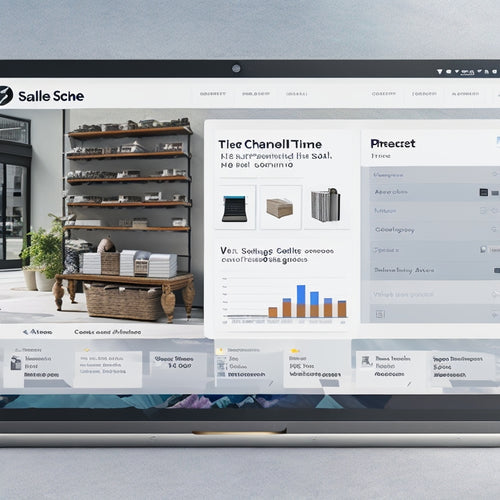
Master Ecommerce Marketing With These 3 Pro Tips
Share
You're just three key strategies away from transforming your ecommerce marketing efforts into a revenue-generating powerhouse. First, diagnose your pain points by evaluating your website design, shipping costs, and customer service metrics. Next, craft data-driven solutions using A/B testing and customer segmentation to increase order value and satisfaction. Finally, optimize your sales funnels strategically to maximize conversions and revenue. By implementing these three pro tips, you'll be well on your way to ecommerce marketing mastery. Now, take the next step to reveal the full potential of your online store.
Key Takeaways
• Identify and address ecommerce pain points, such as poor website design and high shipping costs, to improve customer retention and conversion rates.
• Leverage data-driven solutions, including A/B testing and customer segmentation, to create personalized experiences and increase order value and satisfaction.
• Optimize sales funnels strategically by analyzing customer journeys, identifying leaky areas, and streamlining the process through continual monitoring and A/B testing.
• Implement targeted marketing strategies based on high-value customer segments to maximize ROI and profitability.
• Continuously monitor and optimize ecommerce marketing efforts using data-informed decisions to stay ahead of the competition.
Diagnose Ecommerce Pain Points
Identify the specific areas where your ecommerce business is struggling, as pinpointing pain points is essential to developing a tailored marketing strategy that drives real results.
Take a close look at your website design - is it user-friendly and optimized for conversions? Are you losing customers due to high shipping costs or subpar customer service? These are pivotal areas that can make or break your customer retention rates. You can't afford to ignore them.
Analyze your customer service metrics - are response times slow, leading to frustrated customers? Are your shipping costs eating into your profit margins? By understanding where your business is falling short, you can develop targeted solutions to address these pain points.
For instance, revamping your website design to improve user experience can boost conversions and increase customer retention. Similarly, optimizing your shipping strategy to reduce costs can lead to higher profit margins and increased customer satisfaction.
Craft Data-Driven Solutions
With your pain points diagnosed, you can now leverage data to craft targeted solutions that drive real results, such as A/B testing different website layouts to boost conversions by up to 20%.
By analyzing customer behavior and preferences, you can identify high-value customer segments and create personalized experiences that resonate with them. This customer segmentation strategy can help you increase average order value, reduce cart abandonment, and improve overall customer satisfaction.
To further optimize your ecommerce strategy, use data to inform your A/B testing approach. Test different product recommendations, email subject lines, and social media ads to see what drives the most engagement and conversions.
By continuously iterating and refining your approach based on data insights, you can maximize your ROI and stay ahead of the competition. Remember, data-driven decisions are key to revealing real growth and profitability in ecommerce.
Optimize Sales Funnels Strategically
By analyzing your customer's journey, you can pinpoint leaky areas in your sales funnel and strategically optimize them to maximize conversions and revenue. This is important, as even a 1% increase in your conversion rate can lead to a significant boost in sales.
To optimize your sales funnel, start by identifying pain points in your customer journey. Where are they dropping off? What's causing friction? Use data to inform your decisions, and make adjustments accordingly. For example, if you notice a high bounce rate on your checkout page, simplify the process or offer a guest checkout option.
Next, focus on streamlining your funnel to reduce friction and increase conversions. Use A/B testing to validate changes and make sure they're driving results.
By continually monitoring and optimizing your sales funnel, you can increase revenue, boost customer satisfaction, and stay ahead of the competition.
Frequently Asked Questions
How Do I Balance Personalization With Customer Data Privacy Concerns?
You must strike a balance between personalization and data protection by ensuring transparent data collection, implementing robust customization options, and prioritizing consumer trust to build loyalty and drive conversions.
What Is the Ideal Email Marketing Frequency to Avoid Spam Filters?
You'll avoid spam filters by finding the sweet spot: segment your email lists, AB test frequency, and monitor deliverability and engagement rates to optimize your email marketing frequency for maximum ROI, not annoyance.
Can I Use Influencer Marketing for Niche or B2B Ecommerce Products?
You can leverage influencer marketing for niche or B2B ecommerce products by partnering with micro-influencers who have highly engaged audiences, and creating targeted content that resonates with their followers, driving conversions and ROI.
How Do I Measure the ROI of Social Media Influencer Partnerships?
You'll accurately measure the ROI of social media influencer partnerships by tracking influencer engagement and analytics, then correlating them with sales data to determine ROI tracking and performance metrics that drive real results.
Are There Any Ecommerce Marketing Strategies That Work for Low-Budget Brands?
You can boost sales on a shoestring budget by leveraging organic social media reach and cost-effective content creation strategies, driving conversions without breaking the bank.
Related Posts
-
Why Does My Shopify Store Need a HTML Sitemap?
This article examines the necessity of incorporating an HTML sitemap into Shopify stores. It explores the benefits o...
-
Top Shopify Apps for Boosting Sales and Conversions
Are you struggling to boost sales and conversions on your Shopify store? Look no further! We've got the scoop on the...
-

What Can You Automate on Shopify
This article examines the potential for automation on the Shopify platform. It discusses the benefits of automation ...
